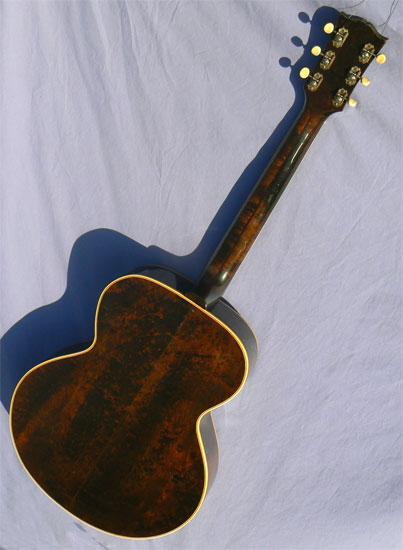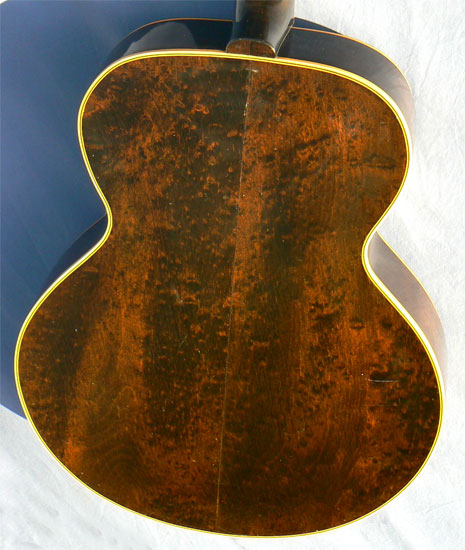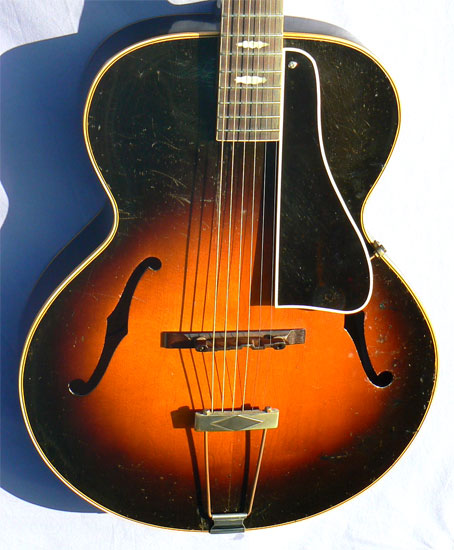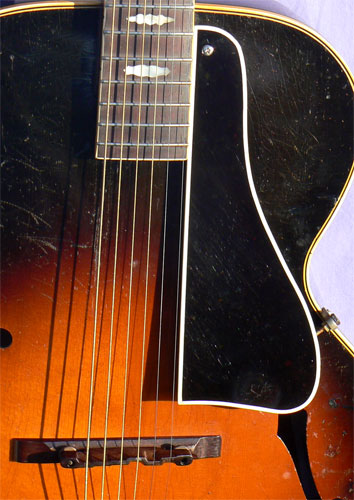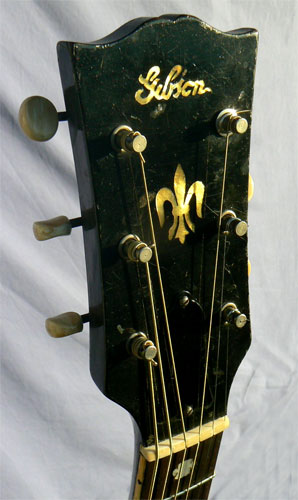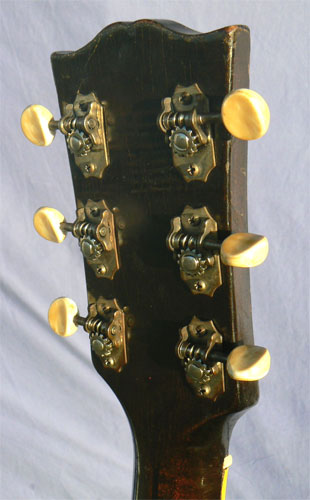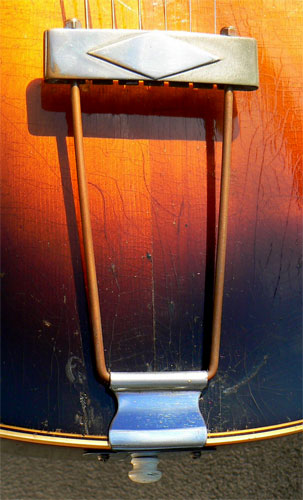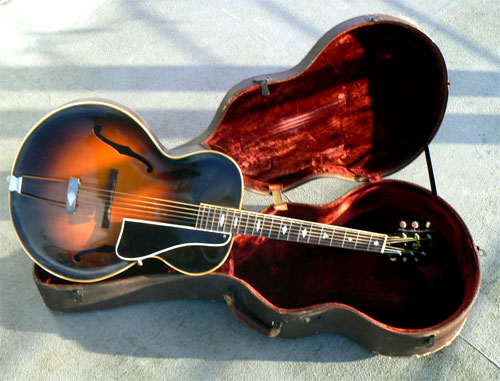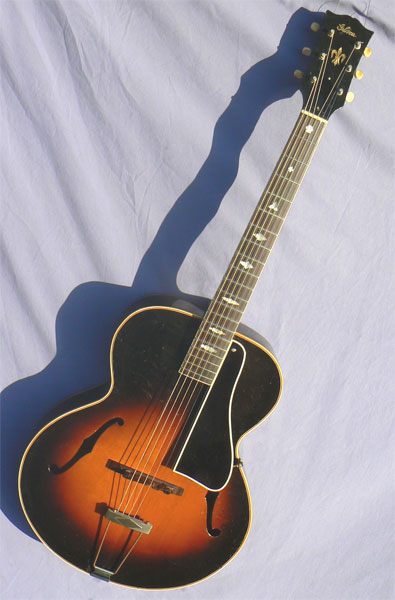 , Long Scale
, Long ScaleHome / Instruments /Accessories / Ordering / Tips / Friends
archtop.com
c.1941 Gibson L-4 , Long Scale
, Long Scale
Status: Pricing and hold status for all instruments currently available is shown on our Instruments page here. If this instrument does not appear on the Instruments page it has been sold, and is no longer available. Photos and descriptions of Previously Sold instruments may by found here. To be notified of examples of this model or similar instruments in the future, please contact [email protected],. Please be specific on which instrument(s) you're looking for, and we'll be happy to contact you as soon as they become available.
Serial #: 98773, white Kalamazoo label FON#: 369-8
Body size at lower bout: 16", Scale length: 25 1/2" Nut: 1 3/4" Neck depth: .91/.97, 1st/10th frets.
Materials: Solid handcarved bookmatched spruce top; solid 3 piece maple neck with walnut centerstripe; solid tiger flame maple sides and back; Brazilian rosewood fingerboard and bridge, split-parallelogram mother of pearl fingerboard inlays and fleur-de-lis headstock inlay; prewar fat script pearl Gibson logo; triple-bound body; bound fingerboard; bone nut.
Hardware: Original nickel hardware includes Waverly open back tuners, 'raised diamond' trapeze tailpiece, compensated adjustable rosewood bridge, adjustable truss rod, bound tortoise pickguard.
Notes: Since its introduction in 1912, the Gibson L-4 has been remarkably consistent in design, with a 16" lower bout, a scale of 24 3/4" in length, and a solid mahogany neck. So influential has been this design that to this day, virtually all 16" archtops have been built with that same short scale neck, no matter the maker. So imagine our surprise when this fascinating guitar showed up.
On the standard 16" L-4 body is a factory installed neck with a long scale 25 1/2" neck, and an extended peghead, both as customary on 17" Gibson archtops like the L-5 and L-7. And the neck is solid maple as well, rather than the usual mahogany. At first we figured it was a custom order, until research later uncovered a handful of similar examples, all from the early 1940's. When regular production resumed after the war, the L-4 promptly reverted to its prewar specs. So what gives?
Here's our best guess. In 1939, Gibson introduced the natural finish as a premium option exclusive to its top-line L-5 and Super 400 models. So popular was the new finish that the firm extended the blonde finish option to its L-7 and L-4 archtops the following year, quickly switching the necks to maple to match the bodies. At this point, Gibson would be able to use a standard maple neck blank on all its L-series archtops, with only cosmetic modifications to differentiate the various models. So for the first time ever, Gibson made a long scale 16" archtop. And also, as it turned out, for the last time as well.
As if this guitar wasn't unusual enough, why would it have the wide 1 3/4" fingerboard as well, which Gibson had generally abandoned by the mid-30's? We have, however, seen these wider nuts occasionally on the 17" L-10, a short lived model which was dropped from the catalog by 1939. Perhaps there were a few left over L-10 neck blanks that were simply grafted on to some L-4 bodies. After all, the factory had been using up 20's vintage Mastertone banjo inlays on the L-4 fretboards for years. Waste not, want not, why not?
And finally, while this guitar's factory order number shows it was built sometime during the early 40's, the label number indicates that it wasn't actually shipped until around 1946. Well, there was a war on, don'tcha know.
Anyhow, there you have it. This rare hybrid combines the comfort of the 16" body, with the snap and projection of the long scale neck. And the generous 1 3/4" nut, so beloved by contemporary players, is ideal for pick or fingerstyle play. Clear, throaty and powerful, the guitar has projection rivalling much larger boxes. The guitar is notably free of buckle, thumb, or fingerboard wear in the all-original Cremona sunburst finish, with a few scattered pick marks on the top, and the back centerseam soundly reglued. The nickel hardware is original as well, with the dark tortoise pickguard showing a small patch of crystallization, but otherwise intact.
The back shows attractive bubble maple under the dark walnut finish, with a soundboard of particularly fine grained bookmatched quartersawn spruce. The fretwork, truss rod and fingerboard are all in great shape, with a fresh precis on setup allowing smooth low action over a classic gentle C profile neck. Finally, unlike postwar examples, this guitar is built with a fully suspended fingerboard, permitting ready installation of a floating pickup. All in its original arched brown plush lined hardshell case.
Combining the clarity and comfort of Loar's 16" L-5 with the power of the 17" neck, this unique instrument is the rarest of birds, with quite a story to unravel. One only: call now.
Setup: Trussrod tension and neck relief adjusted; bridge height adjusted; bridge compensation set; string slots at nut and bridge inspected and recut as necessary; bridge foot contour inspected and fit to top as necessary; bridge radius inspected and recurved as necessary; bridge wheels and tuners lubricated; fingerboard and bridge oiled; body and neck cleaned and hand polished.
This instrument is strung with medium gauge bronze strings (.013). The guitar will accommodate lighter or heavier gauge strings, according to preference. String action is set at 4/64" to 5/64" at the 12th fret, with moderate relief for acoustic playing with medium strings. The action may be lowered or raised to your requirements with the adjustable bridge.
